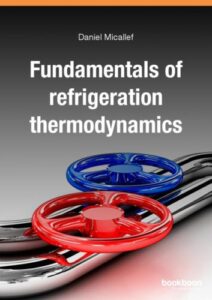Fundamentals of refrigeration thermodynamics
Fundamentals of refrigeration thermodynamics
The aim of Fundamentals of refrigeration thermodynamics is to provide first degree engineering students with the foundations on refrigeration engineering. It covers the basic principles in refrigeration and is not intended to provide specialized knowledge on the subject. Students who further their studies on refrigeration shall still find this book as a good reference. Refrigeration courses could be part of a mechanical, chemical or for instance energy engineering courses. e philosophy employed throughout the entire book is to provide a modern approach to the subject. the later chapters provide fundamental knowledge of refrigeration system simulations. this can be considered as a more advanced topic which is usually more useful to the Masters degree student. Nonetheless, the material presented is comprehensive and will give students a good background of modelling refrigeration systems.
You can also read Collins Complete Plumbing and Central Heating
Fundamentals of refrigeration thermodynamics Content
- Preface
![Fundamentals of refrigeration thermodynamics]()
- Acknowledgements
- Fundamentals of thermodynamics
- Heat engines and reversed heat engines
- Working fluids
- Vapour compression cycles
- Vapour absorption and other cycles
- Principles of numerical modelling and experimentation
- Vapour compression system modelling
- Vapour absorption system modelling
- Appendix
- Bibliography
- Nomenclature
The objective of the book is to serve first degree engineering students with an introduction to refrigeration systems. Typical topics include refrigeration thermodynamics, refrigeration systems and refrigeration modeling. These topics presented in a student friendly manner assuming little to no previous knowledge of thermodynamics. The first part of the book deals with both the fundamentals of thermodynamics necessary in the study of refrigeration as well as the basics of refrigeration systems. The later chapters more focused and slightly more advanced such that the student is introduced to the modeling aspects of refrigeration systems with the use of Mathworks® MATLAB.
The book structured into eight chapters. Chapters 1–3 provide some background thermodynamic knowledge required for refrigeration systems engineering.
Download
Fundamentals of refrigeration thermodynamics
2nd Link Here


Comments are closed.